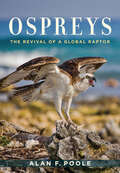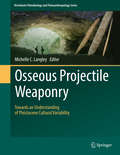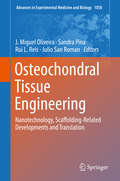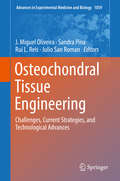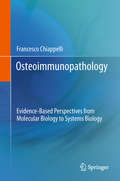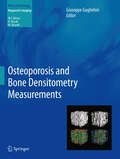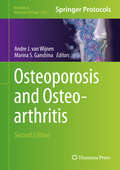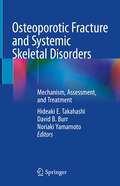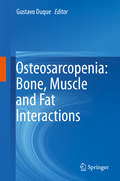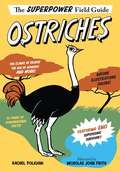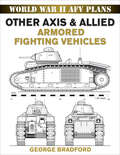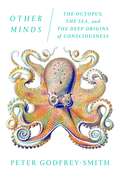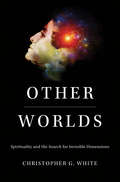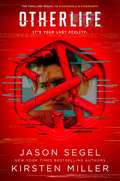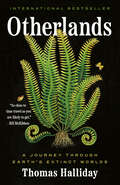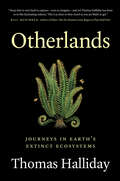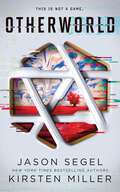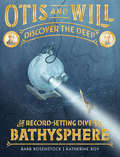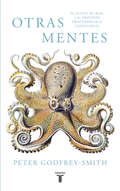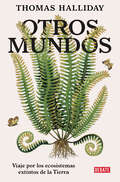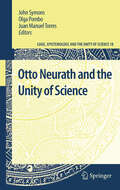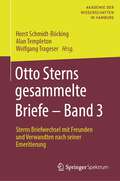- Table View
- List View
Ospreys: The Revival of a Global Raptor
by Alan F. PooleA fascinating look at one of the greatest conservation success stories of the modern era: the wildly popular, unique, and thrilling raptor, the Osprey.Ospreys are one of the few bird species that are found throughout the world. From forests in Hokkaido to rivers in Oregon and islands off Australia, Ospreys steal the show as nature lovers easily watch them build their massive nests and tend to their young. The fact that the Osprey is one of the few large birds that can hover adds to its mystique, and to watch it plunge into the water, emerging with a fish clutched in its talons, is truly a sight one will remember. As widespread as Ospreys are, not long ago they were under threat of extinction. During the 1950s and '60s, scientists tied the decline of Osprey populations to the heavy use of DDT and other human pollutants. In the 1980s, Ospreys began a slow recovery due to the efforts of conservationists and through the resilience of the adaptable raptors themselves. Today they are again considered common in most parts of the world, although some populations remain threatened.In this gorgeously illustrated book, Alan F. Poole, one of America's premier Osprey experts, has written a lyrical exposé of these majestic creatures, describing their daily habits and exploring their relationship with the environment. Ospreys celebrates the species' miraculous recovery from contaminants and hunters, chronicles their spectacular long-distance migrations, and unveils their vital role in bringing life to coastal habitats. Few other birds have such a hold on the human imagination. This book shows us why.
Osseous Projectile Weaponry
by Michelle C. LangleyThis volume presents the current state of knowledge on the osseous projectile weaponry that was produced by Pleistocene cultures across the globe. Through cross-cultural and temporal comparison of manufacturing methods, design, use methods, and associated technology, chapters in this volume identify and discuss differences and similarities between these Pleistocene cultures. The central research questions addressed in this volume include: (a) how did osseous weaponry technology develop and change through time and can these changes be tied to environmental and/or social influences?; (b) how did different Pleistocene cultures design and adapt their osseous weaponry technology to their environment as well as changes in that environment?; and (c) can we identify cultural interaction between neighboring groups through the analysis of osseous weapons technology -- and if so -- can we use these items to track the movement of peoples and/or ideas across the landscape? Through addressing these three central research questions, this volume creates an integrated understanding of osseous technology during a vital period in Modern Human cultural development which will be useful for students and advanced researchers alike.
Osteochondral Tissue Engineering: Challenges, Current Strategies, And Technological Advances (Advances In Experimental Medicine And Biology #1059)
by Rui L. Reis J. Miguel Oliveira Sandra Pina Julio San RomanThis book reviews the most recent developments in the field of osteochondral tissue engineering (OCTE) and presents challenges and strategies being developed that face not only bone and cartilage regeneration, but also establish osteochondral interface formation in order to translate it into a clinical setting. Topics include nanotechnology approaches and biomaterials advances in osteochondral engineering, advanced processing methodology, as well as scaffolding and surface engineering strategies in OCTE. Hydrogel systems for osteochondral applications are also detailed thoroughly. Osteochondral Tissue Engineering: Nanotechnology, Scaffolding-Related Developments and Translation is an ideal book for biomedical engineering students and a wide range of established researchers and professionals working in the orthopedic field.
Osteochondral Tissue Engineering: Challenges, Current Strategies, And Technological Advances (Advances In Experimental Medicine And Biology #1059)
by Rui L. Reis J. Miguel Oliveira Sandra Pina Julio San RomanThis book covers the most recent developments in the field of osteochondral tissue engineering (OCTE) and covers in detail the concepts and current challenges for bone and cartilage repair and regeneration. Specific topics include viscosupplementation, biologicals, tissue engineering approaches, in vitro and in vivo models, and technological advances with stem cells, bioreactors, and microfluidics. Osteochondral Tissue Engineering: Challenges, Current Strategies, and Technological Advances presents challenges and strategies in the field of osteochondral regeneration and serves as a core reference for biomedical engineering students and a wide range of established researchers and professionals working in orthopedics.
Osteoimmunopathology
by Francesco ChiappelliOsteoimmunology pertains to the study of the relationship between the bones, particularly the bone marrow, and the immune system. This monograph pursues the best available evidence, by means of research synthesis, for the characterization of the physiological relevance and pathological implications of the inter-connectedness between the skeletal and the immune system. Research will be discussed that highlights the associated role of the circulatory, nervous and endocrine systems, as well as proteomic and genomic pathways and signatures. Emphasis is given that domain of medicine that relates to the oral cavity, its diseases and their systemic sequelae. This monograph arises from observations that have suggested that the skeletal system and the immune system are intimately intertwined. Chronic inflammatory reactions subsequent to an excessive immune reaction can damage the bones, as in rheumatoid arthritis (RA), osteoporosis, patients seropositive for the human immunodeficiency virus (HIV)-1 and with signs and symptoms of the acquired immune deficiency syndrome (AIDS), and bone cancer. Bones - in particular the bone marrow - are one of the primary locations in which cells of the immune system mature. In brief, this monograph begins to answer a range of questions, such as, what is osteoimmunology all about?, does the immune system and its components affect bone development?, how do stress hormones impact upon the pathophysiology of bone-immune interactions?, can the scientific process of research synthesis, obtain the best available evidence for treatment of diseases involving the bone-immune entity (i.e., osteo immunopathologies) means of evidence-based clinical decision-making directed at the treatment of osteoimmune pathologies?
Osteoporosis
by Jennifer WestendorfThe study of bone cells and tissues at the cellular and molecular levels in a variety of models has revolutionized the field. In this book, leading scientists from around the world share their step-by-step laboratory protocols for studying bone biology. This is the perfect guide for both new and experienced experimentalists attempting to study osteoporosis.
Osteoporosis and Bone Densitometry Measurements
by Giuseppe GuglielmiOsteoporosis is a serious problem worldwide, and its significance is continuing to increase as the world population grows and ages. Osteoporosis and Bone Densitometry Measurements provides a comprehensive review of the latest research on this potentially devastating condition. The book encompasses prevention, diagnosis, and therapy, providing state of the art information on each aspect. A wide range of topics are discussed, including differentiation between acute and chronic, benign and malignant vertebral fractures; the value of the WHO FRAX tool in patient evaluation; the roles of dual-energy X-ray absorptiometry, quantitative computed tomography, quantitative ultrasound, and high-resolution imaging; and the use of kyphoplasty and vertebroplasty to treat vertebral compression fractures. All chapters are written by acknowledged experts in the field.
Osteoporosis and Osteoarthritis (Methods in Molecular Biology #2221)
by Andre J. van Wijnen Marina S. GanshinaThis detailed second edition provides key updates on well-established methods as well as coverage of recently emerging sophisticated techniques and methods that are essential for an in-depth and state-of-the-art understanding of skeletal development and homeostasis and the pathological mechanisms that cause skeletal degeneration. The first half of the book examines cell and molecular biological aspects of osteoarthritis and osteoporosis, while the remainder of the collection focuses on in vivo models of skeletal tissue injury, degeneration, and repair. Written for the highly successful Methods in Molecular Biology series, chapters include introductions to their respective topics, lists of the necessary materials and reagents, step-by-step, readily reproducible laboratory protocols, and tips on troubleshooting and avoiding known pitfalls. Authoritative and up-to-date, Osteoporosis and Osteoarthritis, Second Edition aims to assist investigators concerned with research topics broadly related to osteoporosis, osteoarthritis, intervertebral disc degeneration, as well as other musculoskeletal disorders.
Osteoporotic Fracture and Systemic Skeletal Disorders: Mechanism, Assessment, and Treatment
by David B. Burr Hideaki E. Takahashi Noriaki YamamotoThis edited book describes what fragile bone is, how the condition is assessed, and how it can be treated. It is intended for multi-professional trainees and practitioners in health and social care fields who care for and treat the elderly.Chapters within the book provide the latest advances in cell and molecular biology, morphology, radiology, and the biomechanics of bone in health and disease. The basic concept of “Remodeling” and “Modeling” is described for better understanding of the mechanisms of osteoporosis. Methods of identifying and assessing osteoporosis are described, as are risk factors for bone fracture and non-unions. Furthermore, the effects of various drugs used to treat osteoporosis at both material and structural levels of bone and their cost effectiveness are described. Operative treatments for fracture that maintain or improve the quality of life of patients are includedTreatment of Osteoporotic Fracture and Systemic Skeletal Disorders attempts to provide a holistic and translational view of the pathogenesis and treatment of osteoporosis and some other musculoskeletal diseases, with an overview of treatment modalities in various clinical settings.
Osteosarcopenia: Bone, Muscle and Fat Interactions
by Gustavo DuqueThis edited work presents the most current evidence on osteosarcopenia from bench to bedside, which is expected to facilitate the understanding of this syndrome and to develop preventive and therapeutic strategies. With our aging population, chronic diseases such as osteoporosis and sarcopenia are becoming highly prevalent. Fortunately, our understanding of the bone and muscle interactions has increased in recent years. This has allowed to the coining of the term osteosarcopenia to describe a syndrome in which these two diseases overlap. This overlap between osteoporosis and sarcopenia has major negative effects not only on our older adults but also on health systems worldwide. Readers will find a highly translational approach that starts with a summary of recent discoveries on stem cells biology, muscle and bone interactions – including the role of local bone and muscle fat – followed by comprehensive reviews on myokines (i.e. myostatin), osteokines (i.e. osteocalcin) and adipokines (i.e. interleukins) as major players and determinants of bone and muscle loss with aging. In addition, the role of sex steroids (i.e. estrogens, androgens), and calciotropic hormones (i.e. parathyroid hormone, vitamin D) in the pathogenesis of this syndrome is also reviewed. Moreover, using practical diagnostic and therapeutic tips, this book summarizes the clinical characteristics of osteosarcopenic patients thus facilitating the diagnosis and treatment of this syndrome in clinical practice. Finally, the book presents the case for the Falls and Fractures Clinic as the optimal model of care for this syndrome, aimed to avoid fragmentation and optimize osteosarcopenia care, and simultaneously prevent falls and fractures in older persons.This book offers relevant information on the mechanisms of osteosarcopenia, and a practical guide on how to identify and treat this geriatric syndrome and its adverse outcomes, which are dramatically affecting our aging population.The work is written by leaders in the field and is especially suited not only to any researcher in the musculoskeletal arena but also to medical specialists and allied health professionals involved in the care of older persons.
Ostriches (Superpower Field Guide)
by Rachel PoliquinThis third installment in the hilarious and highly-illustrated full-color Superpower Field Guide series features the silly-looking, surprisingly fierce Ostrich. This two-toed torpedo may have the largest eyes of any animal on dry land, but it can outrun most horses! Meet Eno, an ordinary ostrich living in the Serengeti, a corner of the African savanna. But there's something you should know: Even ordinary ostriches are extraordinary. And that includes Eno. I know what you&’re thinking. You&’re thinking that ostriches are just overgrown chickens with ridiculous necks, skinny legs, and bad attitudes. And you&’re right! Believe it or not, that neck helps ostriches run at supersonic speeds. Those skinny legs can kill a lion dead. And these are only a few weapons in Eno's arsenal of superfierce survival skills—Eno has Colossal Orbs of Telescopic Vision, the Impossible Ever-Flow Lung, the Egg of Wonder, and so many more. You&’re still not convinced that ostriches are superpowered, are you? Well, you don&’t know ostriches yet. But you will.
Other Axis & Allied Armored Fighting Vehicles: World War II AFV Plans (AFV Plans)
by George BradfordThis fully illustrated volume presents an authoritative and highly detailed study of WWII&’s lesser-known armored fighting vehicles. The iconic tanks of WWII, such as America&’s Shermans and the Germany&’s Panzers, have been exhaustively studied. In Other Axis & Allied Armored Fighting Vehicles, military historian and technical artist George Bradford offers an in-depth look at a range of significant yet often-overlooked models. This volume is filled with fine-scale drawings of Australian, Belgian, Canadian, Czech, French, Hungarian, Italian, Japanese, Polish, Romanian, and South African armored vehicles, including: · Centauro Tank Destroyer (Italy) · TKS Light Reconnaissance Tank (Poland) · Ram &“Kangaroo&” Personnel Carrier (Canada) · Renault R-35 Light Tank (France) · Type 3 Chi-nu Heavy Tank (Japan) · Scorpion AC1 Cruiser Tank (Australia) · TACAM R-2 Tank Hunter (Romania) · And many, many more . . .
Other Minds: The Octopus, the Sea, and the Deep Origins of Consciousness
by Peter Godfrey-SmithAlthough mammals and birds are widely regarded as the smartest creatures on earth, it has lately become clear that a very distant branch of the tree of life has also sprouted higher intelligence: the cephalopods, consisting of the squid, the cuttlefish, and above all the octopus. In captivity, octopuses have been known to identify individual human keepers, raid neighboring tanks for food, turn off lightbulbs by spouting jets of water, plug drains, and make daring escapes. How is it that a creature with such gifts evolved through an evolutionary lineage so radically distant from our own? What does it mean that evolution built minds not once but at least twice? The octopus is the closest we will come to meeting an intelligent alien. What can we learn from the encounter? <P><P>In Other Minds, Peter Godfrey-Smith, a distinguished philosopher of science and a skilled scuba diver, tells a bold new story of how subjective experience crept into being―how nature became aware of itself. As Godfrey-Smith stresses, it is a story that largely occurs in the ocean, where animals first appeared. Tracking the mind’s fitful development, Godfrey-Smith shows how unruly clumps of seaborne cells began living together and became capable of sensing, acting, and signaling. As these primitive organisms became more entangled with others, they grew more complicated. The first nervous systems evolved, probably in ancient relatives of jellyfish; later on, the cephalopods, which began as inconspicuous mollusks, abandoned their shells and rose above the ocean floor, searching for prey and acquiring the greater intelligence needed to do so. Taking an independent route, mammals and birds later began their own evolutionary journeys. <P><P>But what kind of intelligence do cephalopods possess? Drawing on the latest scientific research and his own scuba-diving adventures, Godfrey-Smith probes the many mysteries that surround the lineage. How did the octopus, a solitary creature with little social life, become so smart? What is it like to have eight tentacles that are so packed with neurons that they virtually “think for themselves”? What happens when some octopuses abandon their hermit-like ways and congregate, as they do in a unique location off the coast of Australia? <P><P>By tracing the question of inner life back to its roots and comparing human beings with our most remarkable animal relatives, Godfrey-Smith casts crucial new light on the octopus mind―and on our own.
Other Senses, Other Worlds
by Doris Jonas David JonasScientific evidence now substantiates science fiction fantasies: we will meet alien beings on other planets--possibly in our own solar system, surely in other galaxies. What shapes will they take? What kinds of intelligence can we expect? How will we communicate? Here two scientists provide authoritative speculation on the nature of extra-terrestrial life, beginning their investigation with a survey of sensory perception on earth--not just our five senses, but the senses we lack that are found in other forms of life. Based on accepted facts about the environments of other planets they have created fascinating and indeed probable scenarios for a whole range of other worlds, complete with intelligent life forms, social structures, and life-styles.
Other Worlds: Spirituality and the Search for Invisible Dimensions
by Christopher G. WhiteWhat do modern multiverse theories and spiritualist séances have in common? Not much, it would seem. One is an elaborate scientific theory developed by the world’s most talented physicists. The other is a spiritual practice widely thought of as backward, the product of a mystical world view fading under the modern scientific gaze. But Christopher G. White sees striking similarities. He does not claim that séances or other spiritual practices are science. Yet he points to ways that both spiritual practices and scientific speculation about multiverses and invisible dimensions are efforts to peer into the hidden elements and even the existential meaning of the universe. Other Worlds examines how the idea that the universe has multiple, invisible dimensions has inspired science fiction, fantasy novels, films, modern art, and all manner of spiritual thought reaching well beyond the realm of formal religion. Drawing on a range of international archives, White analyzes how writers, artists, filmmakers, televangelists, and others have used the scientific idea of invisible dimensions to make supernatural phenomena such as ghosts and miracles seem more reasonable and make spiritual beliefs possible again for themselves and others. Many regard scientific ideas as disenchanting and secularizing, but Other Worlds shows that these ideas—creatively appropriated in such popular forms as C. S. Lewis’s Chronicles of Narnia, the art of Salvador Dalí, or the books of the counterculture physicist “Dr. Quantum”—restore a sense that the world is greater than anything our eyes can see, helping to forge an unexpected kind of spirituality.
OtherLife: Last Reality Series
by Kirsten Miller Jason SegelThe eagerly anticipated third instalment in the fast-paced Last Reality series Simon, Kat, Busara, and Elvis are on the run with the tech super-villains at the Company hot on their heels. The new VR gaming experience the Company created, OtherEarth, is set to change how the world experiences video games. Paired with the hardware the Company developed, it has the potential to change the world as we know it, altering our reality forever. The Company is on its way to becoming the world's newest superpower. And Simon is determined to shut them down forever. But to do that, he'll have to survive OtherLife – the next phase of gaming, and a complete reality reboot.
Otherlands: A Journey Through Earth's Extinct Worlds
by Thomas HallidayThe past is past, but it does leave clues, and Thomas Halliday has used cutting-edge science to decipher them more completely than ever before. In Otherlands, Halliday makes sixteen fossil sites burst to life on the page. <p><p> This book is an exploration of the Earth as it used to exist, the changes that have occurred during its history, and the ways that life has found to adapt―or not. It takes us from the savannahs of Pliocene Kenya to watch a python chase a group of australopithecines into an acacia tree; to a cliff overlooking the salt pans of the empty basin of what will be the Mediterranean Sea just as water from the Miocene Atlantic Ocean spills in; into the tropical forests of Eocene Antarctica; and under the shallow pools of Ediacaran Australia, where we glimpse the first microbial life. <p><p> Otherlands also offers us a vast perspective on the current state of the planet. The thought that something as vast as the Great Barrier Reef, for example, with all its vibrant diversity, might one day soon be gone sounds improbable. But the fossil record shows us that this sort of wholesale change is not only possible but has repeatedly happened throughout Earth history. Even as he operates on this broad canvas, Halliday brings us up close to the intricate relationships that defined these lost worlds. <p><p> In novelistic prose that belies the breadth of his research, he illustrates how ecosystems are formed; how species die out and are replaced; and how species migrate, adapt, and collaborate. It is a breathtaking achievement: a surprisingly emotional narrative about the persistence of life, the fragility of seemingly permanent ecosystems, and the scope of deep time, all of which have something to tell us about our current crisis.
Otherlands: Journeys in Earth's Extinct Ecosystems
by Thomas HallidaySapiens for natural history: a stirring, eye-opening journey into deep time, from the Ice Age to the first appearance of microbial life 550 million years ago, by a brilliant young paleobiologist.The past is past, but it does leave clues, and Thomas Halliday has used cutting-edge science to decipher them more completely than ever before. In Otherlands, Halliday makes sixteen fossil sites burst to life on the page.This book is an exploration of the Earth as it used to exist, the changes that have occurred during its history, and the ways that life has found to adapt-or not. It takes us from the savannahs of Pliocene Kenya to watch a python chase a group of australopithecines into an acacia tree; to a cliff overlooking the salt pans of the empty basin of what will be the Mediterranean Sea just as water from the Miocene Atlantic Ocean spills in; into the tropical forests of Eocene Antarctica; and under the shallow pools of Ediacaran Australia, where we glimpse the first microbial life. Otherlands also offers us a vast perspective on the current state of the planet. The thought that something as vast as the Great Barrier Reef, for example, with all its vibrant diversity, might one day soon be gone sounds improbable. But the fossil record shows us that this sort of wholesale change is not only possible but has repeatedly happened throughout Earth history.Even as he operates on this broad canvas, Halliday brings us up close to the intricate relationships that defined these lost worlds. In novelistic prose that belies the breadth of his research, he illustrates how ecosystems are formed; how species die out and are replaced; and how species migrate, adapt, and collaborate. It is a breathtaking achievement: a surprisingly emotional narrative about the persistence of life, the fragility of seemingly permanent ecosystems, and the scope of deep time, all of which have something to tell us about our current crisis.
Otherworld: Last Reality Series (Last Reality Ser. #1)
by Kirsten Miller Jason Segel"Full of high stakes, thrillers, and fantastic twists and turns, fans of Ready Player One are sure to love this addictive read." —BUZZFEED Welcome to real life 2.0. Are you ready to play? There are no screens. There are no controls. You don&’t just see and hear it – you taste, smell, and touch it too. In this new reality there are no rules to follow, no laws to break. You can live your best life. It&’s a game so addictive you&’ll never want it to end. Until you realize that you&’re the one being played. Step into Otherworld. Leave your body behind. The frightening future that Jason Segel and Kirsten Miller have imagined is not far away. Otherworld asks the question we'll all soon be asking: if technology can deliver everything we want, how much are we willing to pay?
Otherworldly Antarctica: Ice, Rock, and Wind at the Polar Extreme
by Edmund StumpWith stunning original photographs, an Antarctic scientist and explorer takes us to one of the most sublime, remote, and pristine regions on the planet. The interior of Antarctica is an utterly pristine wilderness, a desolate landscape of ice, wind, and rock; a landscape so unfamiliar as to seem of another world. This place has been known to only a handful of early explorers and the few scientists fortunate enough to have worked there. Edmund Stump is one of the lucky few. Having climbed, photographed, and studied more of the continent-spanning Transantarctic Mountains than any other person on Earth, this geologist, writer, and photographer is uniquely suited to share these alien sights. With stories of Stump’s forty years of journeys and science, Otherworldly Antarctica contains 130 original color photographs, complemented by watercolors and sketches by artist Marlene Hill Donnelly. Over three chapters—on the ice, the rock, and the wind—we meet snowy paths first followed during Antarctica’s Heroic Age, climb the central spire of the Organ Pipe Peaks, peer into the crater of the volcanic Mount Erebus, and traverse Liv Glacier on snowmobile, while avoiding fatal falls into the blue interiors of hidden crevasses. Along the way, we see the beauty of granite, marble, and ice-cored moraines, meltwater ponds, lenticular clouds, icebergs, and glaciers. Many of Stump’s breathtaking images are aerial shots taken from the planes and helicopters that brought him to the interior. More were shot from vantages gained by climbing the mountains he studied. Some were taken from the summits of peaks. Many are of places no one had set foot before—or has since. All seem both permanent and precarious, connecting this otherworld to our fragile own.
Otis and Will Discover the Deep: The Record-Setting Dive of the Bathysphere
by Katherine Roy Barb RosenstockThe suspenseful, little-known true story of two determined pioneers who made the first dive into the deep ocean.On June 6, 1930, engineer Otis Barton and explorer Will Beebe dove into the ocean inside a hollow metal ball of their own invention called the Bathysphere.They knew dozens of things might go wrong. A tiny leak could shoot pressurized water straight through the men like bullets! A single spark could cause their oxygen tanks to explode! No one had ever dived lower than a few hundred feet...and come back. But Otis and Will were determined to become the first people to see what the deep ocean looks like.This suspenseful story from acclaimed author Barb Rosenstock with mesmerizing watercolors by award-winning artist Katherine Roy will put you right in the middle of the spine-tingling, record-setting journey down, down into the deep.
Otras mentes. El pulpo, el mar y los orígenes profundos de la consciencia
by Peter Godfrey-SmithEl libro del año para mentes curiosas, lo más parecido a un encuentro alienígena. «Una fabulosa mezcla de encuentros a lo Cousteau con cefalópodos, apasionantes discusiones científicas y reflexión filosófica. Maravillosamente escrito, estimulante y audaz.» Olivia Judson, The Atlantic En una rama muy distante de la nuestra en el árbol de las especies surgió otra mente elevada: la de los cefalópodos. Pero, ¿qué clase de inteligencia poseen estos animales? ¿Cómo desarrolló tal inteligencia el pulpo, criatura de escasa vida social y longevidad de apenas dos años? Otras mentes es una nueva y audaz historia de cómo la naturaleza se hizo consciente de sí misma, un relato que transcurre en gran medida en el mar. Peter Godfrey-Smith, distinguido filósofo de la ciencia y hábil buceador, describe sus impresionantes encuentros con octópodos y las travesuras perpetradas por pulpos cautivos al tiempo que traza el asombroso viaje evolutivo de los cefalópodos, una ruta alejada de la que más tarde tomaríamos los mamíferos. Una inmersión profunda y excepcionalmente reveladora en los orígenes de la experiencia subjetiva. Críticas:«El tema es tan asombroso que es difícil no sentirse seducido, como le pasó al propio autor cuando le extendió una mano a un pulpo y éste se acercó para devolverle el toque, en clara señal de interés.»Irene Wanner, The Seattle Times «Fascinante. Después de leer este libro, parafraseando a Byron, "no amarás menos al hombre, sino más a los cefalópodos".»Callum Roberts, The Washington Post «El filósofo Godfrey-Smith combina hábilmente ciencia, filosofía y sus propias experiencias nadando entre estos animales tentaculares para iluminar el origen y la naturaleza de la conciencia.»The Economist «Godfrey-Smith se ha impuesto un doble reto: por un lado, recoger todo lo que sabemos sobre la conducta y el conocimiento de los pulpos y, por otro, mostrar por qué esta información es a su vez un reto de cara a nuestra concepción filosófica y científica de la mente. El resultado es de lo más convincente.»Science «Si esto es filosofía, funciona. Godfrey-Smith es uno de esos filósofos que buscan pistas en el mundo. Sabio y curioso, nunca resulta dogmático y es sorprendentemente agudo.»Carl Safina, The New York Times Book Review «Godfrey-Smith enlaza hábilmente historia evolutiva y biología con los debates filosóficos más amplios sobre la naturaleza.»Nick Romeo, The Chicago Tribune «Una magistral combinación de historia natural, filosofía y curiosidad. De lectura obligada para cualquier persona interesada en la evolución de la mente.»Jennifer Ackerman, autora de El ingenio de los pájaros «Una deslumbrante muestra de la mejor pop science. Increíblemente revelador y divertido.»Meehan Crist, Los Angeles Times
Otros mundos: Viaje por los ecosistemas extintos de la Tierra
by Thomas Halliday«Un viaje caleidoscópico y evocador. Halliday toma silenciosos registros fósiles y les da vida de manera desenfrenada, a todo color y en 3D».Andrea Wulf «Este libro de riquezas casi inimaginables bien podría ser el mejor de 2022, y eso que aún estamos en enero».The Sunday Times ¿Cómo era nuestro planeta hace cientos de millones de años? ¿Cómo se recuperó la vida en la Tierra tras las extinciones más devastadoras? El pasado deja huellas, y Thomas Halliday, joven investigador multipremiado, ha utilizado la ciencia de vanguardia para descifrarlas de forma más completa que nunca. Con mirada lúcida y poética, lee las huellas en la arena helada para llevarnos en un increíble viaje en el tiempo por unos mundos al mismo tiempo fabulosos y familiares. Otros mundos devuelve a la vida dieciséis ecosistemas de un pasado inimaginablemente remoto y nos muestra continentes en movimiento, arrecifes de cristal, hongos de tres metros de altura, pingüinos gigantes, reptiles emplumados y muchas otras criaturas asombrosas de un atractivo casi mitológico. A medida que viajamos hacia atrás en el tiempo, redescubrimos nuestro propio hogar de formas irreconocibles, y nos sobrecogen los ecosistemas que se transforman y los devastadores escenarios que han causado el fin de incontables especies. No obstante, por fortuna, la vida siempre ha terminado imponiéndose... por ahora. Este maravilloso libro es también una advertencia del inquietante futuro que afronta nuestro planeta. Reseñas:«Absolutamente apasionante. La Tierra ha alojado mundos muy diferentes a lo largo de su historia, y Halliday es el guía perfecto para mostrárnoslos, así como a las extraordinarias criaturas que los habitaron».Lewis Dartnell «El mejor libro que he leído sobre la historia de la vida en la Tierra».Tom Holland «Un relato extraordinario. Épicamente cinematográfico, este libro de riquezas casi inimaginables bien podría ser el mejor de 2022, y eso que aún estamos en enero».The Sunday Times «Extraordinario, brillante. Una obra de inmensa creatividad firmemente arraigada en la ciencia actual».The Scotsman «Fascinante. No solo estas tierras y criaturas extrañas resultan maravillosas, también lo es descubrir que la ciencia puede darles vida con detalles tan poderosos».The New Scientist «Una voz única. Un festín. Se aprenden hechos asombrosos».Steve Brusatte, Scientific American «Deslumbrante. El autor convierte un árido periodo de la historia en algo fascinante».Publishers Weekly «Un viaje a las profundidades del tiempo en un libro épico».The Independent «Magnífico. Una historia épica, alucinante, de la Tierra. Deslumbrante».The Telegraph «Una biografía de la Tierra de gran alcance y lirismo».BBC Radio 4 Start the Week «Brillante. Un intrincado análisis del pasado interconectado de nuestro planeta. Es imposible leerlo sin impresionarse ante lo que está por venir».The Independent «Fascinante. Una lectura intensa y original de los fósiles como runas que nos hablan de nuestro tiempo y de nuestro futuro».Tortoise
Otto Neurath and the Unity of Science
by Olga Pombo John Symons Juan Manuel TorresThis volume critically reexamines Otto Neurath's conception of the unity of science. Some of the leading scholars of Neurath's work, along with many prominent philosophers of science critically examine his place in the history of philosophy of science and evaluate the relevance of his work for contemporary debates concerning the unity of science.
Otto Sterns gesammelte Briefe – Band 3: Sterns Briefwechsel mit Freunden und Verwandten nach seiner Emeritierung
by Horst Schmidt-Böcking Alan Templeton Wolfgang TrageserIn diesem mehrbändigen Werk finden sich die Briefwechsel des bedeutenden Physikers und Nobelpreisträgers Otto Stern (1888–1969). Das Besondere an dieser Sammlung ist, dass die einzelnen Bände nicht streng chronologisch, sondern nach Themen und Personen angeordnet sind, um je einen Themenschwerpunkt im Leben Sterns im Zusammenhang vorzustellen. Erklärende Texte zwischen den Briefen ermöglichen ein tieferes Verständnis der wissenschaftlichen und historischen Zusammenhänge. Das Werk richtet sich damit nicht nur an Wissenschaftshistoriker, sondern an alle interessierten Leser, die mehr über Otto Stern und sein Wirken erfahren möchten.Im vorliegenden dritten Band werden im Wesentlichen seine Briefe nach seiner Emeritierung im Jahre 1945 vorgestellt. Aus der Zeit davor werden noch einige dienstliche Briefe mit Universitätsverwaltungen, seine Konferenzbesuche betreffend, aufgeführt. Die Darstellung der Briefe in diesem Band erfolgt in chronologischer Reihenfolge und zeigt eine wichtige Seite des Menschen Otto Stern.Sie belegen seine rege Teilnahme an nationalen und internationalen wissenschaftlichen Veranstaltungen und Konferenzen und zeigen Sterns große internationale Bedeutung bei der Entstehung der modernen Quantenphysik. Viele Briefe aus der Nachkriegszeit dokumentieren seine zahlreichen und langen Gastaufenthalte in der von ihm geliebten Schweiz. Der Briefwechsel der letzten Jahre seines Lebens stellt ein schrittweises Abschiednehmen dar, das gekennzeichnet ist durch den weiterhin gepflegten lebenslangen Kontakt zu bestimmten Personen, einigen Kollegen, Freunden und Verwandten. Mit diesem Werk soll an den herausragenden Physiker und Menschen Otto Stern erinnert werden, der mit seinen genialen Experimentierverfahren Vater des Stern-Gerlach-Experiments war und zusammen mit Walther Gerlach dieses in genialer Weise durchführte. Dies war ein Meilenstein für die Entwicklung der modernen Quantenphysik.
